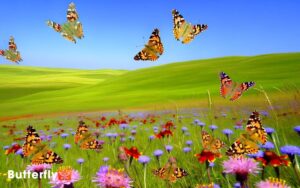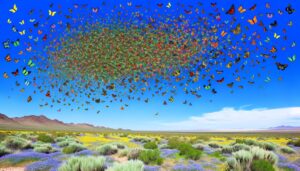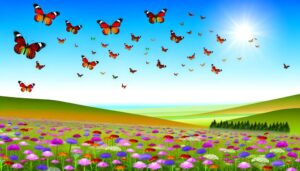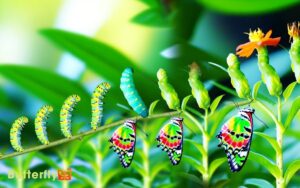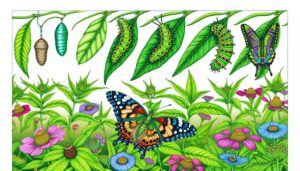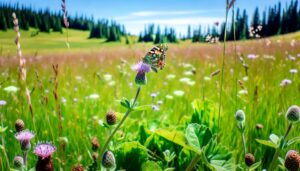Australian Painted Lady Butterfly Facts: Discover!
The Australian Painted Lady butterfly, Vanessa kershawi, belongs to the Nymphalidae family within the Lepidoptera order. It has a wingspan of approximately 50 millimeters.
They primarily feed on nectar from plants like daisies and milkweeds and face threats from predators and habitat loss. Their migratory behavior and courtship rituals are fascinating aspects of their biology. Future insights await curiosity.
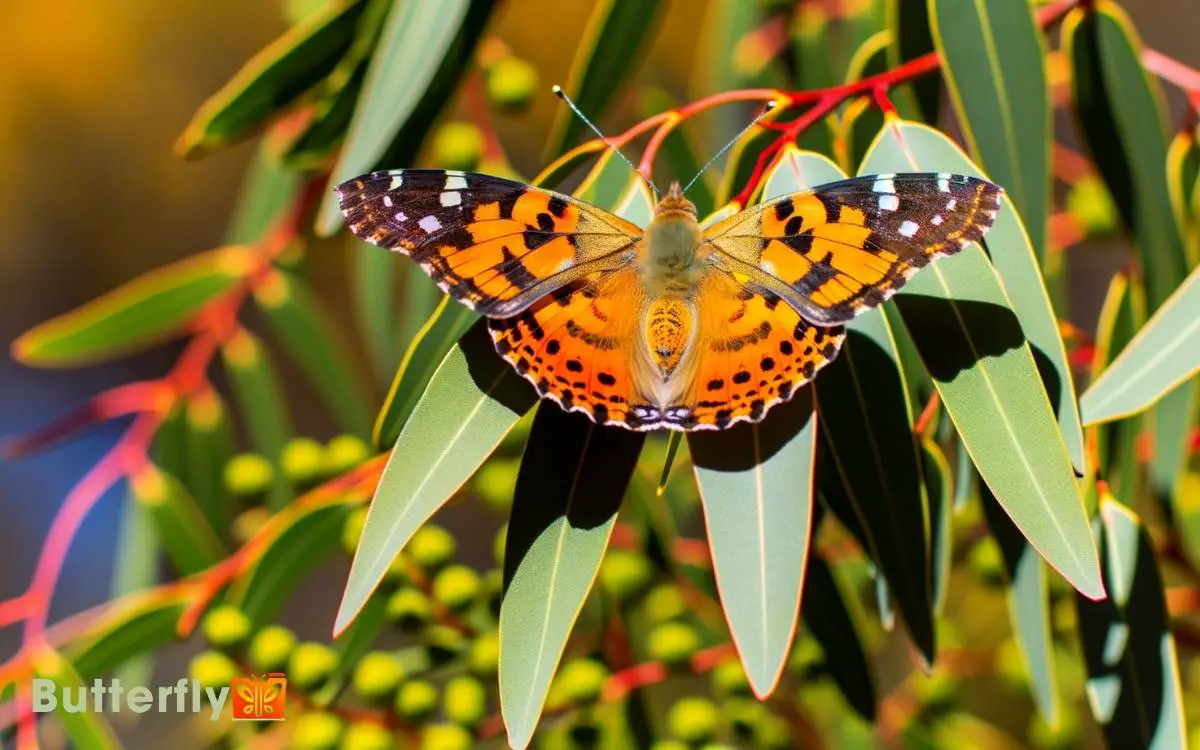
Key Takeaways
Scientific Classification
The Australian Painted Lady, scientifically known as Vanessa kershawi, belongs to the family Nymphalidae within the order Lepidoptera. This classification places it among the largest families of butterflies, which includes over 6,000 species.
Vanessa kershawi is further categorized under the genus Vanessa, renowned for species with strikingly patterned wings.
The Nymphalidae family, often referred to as the brush-footed butterflies, is characterized by reduced forelegs that aren’t used for walking.
Lepidoptera, the order encompassing both butterflies and moths, is distinguished by members that undergo complete metamorphosis.
This taxonomic hierarchy underscores the evolutionary relationships and ecological adaptations that define the Australian Painted Lady.
Understanding this classification provides insight into its biological and ecological niche.
Physical Description
Vanessa kershawi boasts a wingspan of approximately 50 millimeters, with its forewings displaying vibrant orange and black patterns, punctuated by white spots near the wing tips.
The hindwings are more subdued, featuring a mixture of brown and gray tones, with a series of small blue and black eyespots along the edges.
The butterfly’s body is robust and covered with fine scales, aiding in thermoregulation and flight. Its antennae are clubbed, facilitating navigation and sensory perception. The legs are slender but strong, adapted for clinging onto various surfaces.
The underside of the wings reveals a cryptic coloration, providing camouflage against predators when the butterfly is at rest. This intricate design enhances its survival and adaptability in diverse environments.
Color Patterns
The Australian Painted Lady butterfly exhibits distinct wing coloration variations, marked by intricate patterns of orange, black, and white.
These patterns can change seasonally, influenced by environmental factors such as temperature and humidity.
Understanding these color patterns provides insights into their adaptive strategies and ecological interactions.
Wing Coloration Variations
Examining the wing coloration variations in the Australian Painted Lady butterfly reveals intricate patterns and hues that serve multiple biological functions.
The dorsal side of the forewings typically displays orange and black patches with white spots, designed to deter predators by mimicking larger, more threatening creatures.
Conversely, the ventral side features a more cryptic coloration, with brown and gray tones interspersed with eye-like spots. This camouflage aids in blending with the environment, reducing predation risk.
Additionally, ultraviolet reflective scales on the wings play a role in mate attraction and species recognition.
Each color pattern is a result of genetic and environmental factors, contributing to the butterfly’s survival and reproductive success in diverse habitats.
Seasonal Color Changes
Observing the Australian Painted Lady butterfly across different seasons reveals notable shifts in its wing coloration patterns.
During the warmer months, the butterfly exhibits vibrant, orange-hued wings with pronounced black and white spots. These colors serve as both a visual deterrent to predators and a means of thermoregulation.
As temperatures drop, the butterfly’s wings adopt more subdued tones, with increased brown and gray shades. This seasonal color adaptation enhances camouflage, aiding in survival during winter months.
The change is a result of environmental factors influencing pigment production and distribution within the wing scales.
Understanding these seasonal color changes provides insights into the butterfly’s adaptive strategies and ecological interactions, highlighting the intricate relationship between environmental conditions and biological responses.
Lifecycle Stages
From egg to adult, the lifecycle stages of the Australian Painted Lady butterfly exhibit a fascinating sequence of metamorphosis.
Starting as tiny, pale green eggs, they hatch into spiny caterpillars within around five days. These larvae feed voraciously on host plants, growing and molting through several instar stages over roughly two weeks.
Once fully grown, the caterpillar forms a chrysalis, suspending itself from a secure substrate. Inside the chrysalis, remarkable transformation occurs over ten to fourteen days. The adult butterfly emerges, expanding and drying its wings in preparation for flight.
This entire process, from egg to adult, spans approximately four weeks, highlighting the intricate and efficient progression of the Australian Painted Lady’s developmental stages.
Mating Behavior
The Australian Painted Lady butterfly’s mating behavior includes intricate courtship rituals and displays, which are vital for successful reproduction.
Males perform aerial displays and release pheromones to attract females, who then evaluate potential mates based on these signals.
This mate selection process guarantees genetic diversity and species survival.
Courtship Rituals and Displays
Male Australian Painted Lady butterflies guarantee courtship by performing intricate flight patterns to attract a potential mate. This behavior includes rapid wing flapping and hovering close to the female.
The males’ displays serve several purposes:
- Visual Attraction: Their colorful wings and precise maneuvers catch the female’s attention.
- Territorial Assertion: Males often perform these displays within a specific territory to ward off rivals.
- Olfactory Signals: Pheromones released during flight enhance their appeal.
- Proximity Testing: Approaching closely tests the female’s receptiveness.
These courtship rituals are critical for successful mating. The males’ displays guarantee that only the most fit and persistent individuals proceed to the next stage.
This intricate dance of attraction exemplifies the complex mating behavior of the Australian Painted Lady butterfly.
Mate Selection Criteria
Female Australian Painted Lady butterflies evaluate potential mates based on wing coloration, flight agility, and pheromone strength, ensuring compatibility and genetic fitness.
Wing coloration serves as an indicator of overall health; vibrant hues suggest a lack of parasites and robust genetic makeup.
Flight agility demonstrates physical fitness and the ability to evade predators, essential for survival.
Pheromone strength plays a key role in mate selection, signaling reproductive viability and genetic diversity.
Males emit these chemical cues during courtship flights, and females assess the intensity and composition.
Preferred Habitats
Australian Painted Lady butterflies thrive in diverse habitats, including coastal dunes, open woodlands, and suburban gardens. They’re adaptable insects, finding suitable environments across various landscapes.
Key habitat preferences include:
- Coastal Dunes: These areas provide abundant nectar sources and sheltered spots for laying eggs.
- Open Woodlands: A mix of sunlight and shaded regions supports their thermoregulation and feeding needs.
- Suburban Gardens: Gardens offer a variety of flowering plants and are often pesticide-free, promoting healthy butterfly populations.
- Grasslands: Open fields with plentiful wildflowers serve as prime locations for nectar feeding and mating.
Australian Painted Ladies demonstrate resilience by thriving in environments where plant diversity supports their life cycle stages, from larval host plants to adult nectar sources.
Feeding Habits
The Australian Painted Lady butterfly primarily feeds on nectar from flowering plants. It favors species such as daisies and lantanas.
Its larvae consume a variety of host plants, including everlastings and other members of the Asteraceae family.
This dual strategy guarantees both adult and larval stages have adequate nutritional resources for survival and reproduction.
Nectar Sources
With their proboscis, Australian Painted Lady butterflies efficiently extract nectar from a variety of flowering plants, including daisies, lantanas, and buddleias.
These butterflies exhibit distinct feeding preferences and behaviors. They seek out flowers that provide ample nectar, ensuring their energy needs are met.
Key nectar sources include:
- Daisies: Commonly found and rich in nectar, daisies serve as a primary food source.
- Lantanas: These flowers attract butterflies with their vibrant colors and abundant nectar.
- Buddleias: Known as butterfly bushes, they produce large clusters of nectar-rich flowers.
- Milkweeds: These plants also offer high nectar content, making them ideal for feeding.
Understanding these preferences helps in conserving their habitat and supporting butterfly populations.
Larval Host Plants
While adult butterflies focus on nectar sources, the larvae of the Painted Lady butterflies have specific host plants essential for their development. These larvae primarily feed on plants from the Asteraceae family, including thistles, daisies, and sunflowers.
The selection of these host plants is important as they provide the necessary nutrients for the larvae to grow and eventually pupate.
In addition to the Asteraceae family, larvae may also consume plants from the Malvaceae and Fabaceae families. The caterpillars exhibit a preference for young, tender leaves which are easier to digest.
Understanding these larval feeding habits is crucial for conservation efforts, as the availability of these host plants directly impacts the survival and proliferation of the Painted Lady butterfly population.
Migratory Routes
Australian Painted Lady butterflies undertake extensive migratory journeys, spanning thousands of kilometers across various terrains.
These migrations are primarily secured by the availability of food and suitable breeding sites. Migratory patterns are influenced by seasonal changes and climatic conditions.
The butterflies typically follow these routes:
- Northward Migration: During spring, they move from southern Australia to northern regions seeking blooming flora.
- Southward Return: In autumn, they return to southern areas to escape the northern dry season.
- Transcontinental Flights: Some populations cross the Bass Strait to reach Tasmania.
- Intercontinental Movements: Rarely, they may venture towards New Zealand due to strong winds.
These intricate migratory behaviors safeguard the species’ survival across diverse Australian landscapes.
Predators and Threats
Natural predators and environmental threats greatly influence the survival rates of Australian Painted Lady butterflies. Birds, particularly insectivorous species, frequently prey on both larvae and adult butterflies.
In addition, parasitic wasps and flies target their caterpillars, greatly reducing their numbers before they can reach maturity.
Environmental factors also play a critical role. Habitat loss due to urbanization and agricultural expansion reduces the availability of host plants, essential for larval development. Pesticide use in farming areas can also be lethal, contaminating the plants they feed on.
Climate change, altering temperature and precipitation patterns, disrupts their migratory routes and breeding cycles. Collectively, these threats pose substantial challenges to their populations, necessitating further study and awareness.
Conservation Status
Given the numerous threats they face, the conservation status of the Australian Painted Lady butterfly requires vigilant monitoring to guarantee their populations remain sustainable.
Their current status isn’t classified as endangered, but ongoing habitat loss and climate change present significant risks.
Effective conservation strategies include:
- Habitat Preservation: Protecting and restoring natural habitats to support breeding and feeding.
- Climate Change Mitigation: Implementing measures to reduce greenhouse gas emissions and mitigate climate impacts.
- Research and Monitoring: Conducting regular surveys to track population trends and health.
- Public Education: Raising awareness about the importance of butterflies and promoting conservation efforts.
Role in Ecosystem
Frequently overlooked, the Painted Lady butterfly plays an essential role in ecosystems through pollination and serving as a food source for various predators.
These butterflies contribute to pollination by visiting flowers and transferring pollen, which facilitates plant reproduction. Their migratory patterns help distribute pollen over vast distances, enhancing genetic diversity among plant populations.
Additionally, Painted Lady larvae and adults provide vital nourishment for birds, spiders, and other insects, supporting the food web’s balance.
Predation on these butterflies helps regulate their population, preventing overgrazing on host plants. This intricate interaction underscores their significance in maintaining ecological equilibrium.
To summarize, the Painted Lady butterfly is indispensable for pollination and as a prey species, reinforcing its critical ecological role. According to the Carolina Biological Painted Lady Overview, this butterfly’s migratory patterns contribute to the dispersal of pollen across vast regions, benefiting numerous plant species. Additionally, its adaptability to various habitats ensures its presence in diverse ecosystems, where it serves as a key food source for birds and other predators. This resilience highlights the Painted Lady’s vital role in maintaining ecological balance.
Interesting Tidbits
One fascinating aspect of the Painted Lady butterfly is its remarkable migratory capability, allowing it to travel thousands of kilometers across continents.
They exhibit several intriguing behaviors and characteristics that make them a subject of interest:
- Flight Speed and Endurance: Painted Ladies can fly at speeds up to 30 kilometers per hour and cover distances of up to 1,600 kilometers in a single journey.
- Diet: Their larvae feed on a variety of host plants, including thistles and mallows, making them adaptable to different environments.
- Lifespan: The adult butterfly typically lives for about two weeks, during which it focuses on reproduction.
- Coloration: Their vibrant color patterns serve as camouflage and a warning to predators, contributing to their survival.
Conclusion
The Australian Painted Lady butterfly symbolizes nature’s intricate beauty and resilience. Through its vivid color patterns, complex lifecycle, and adaptive mating behaviors, it represents the delicate balance of ecosystems.
Despite facing predators and human-induced threats, its survival underscores the significance of conservation efforts. This butterfly isn’t just a fleeting spectacle but an essential thread in nature’s tapestry, reminding us of the interconnectedness and fragility of our environment.

